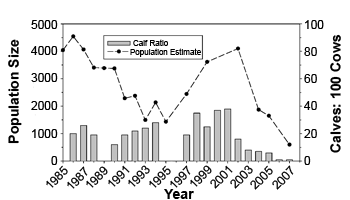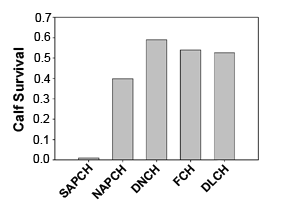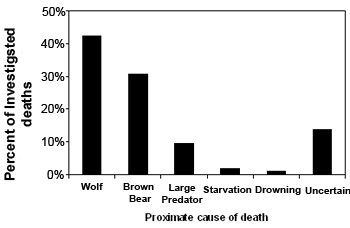Intensive Management in Alaska
Predator Management for the Southern Alaska Peninsula Caribou Herd
Facing a "serious conservation concern," in the spring of 2008, members of the Alaska Board of Game adopted a predator management program to help a severely declining caribou herd in Game Management Unit 9D (Figure 1). At that time, the Southern Alaska Peninsula (SAP) herd numbered approximately 600 caribou, down from a historical high of 10,000 caribou in 1983.

"It would be irresponsible in this case for us not to take action to help this herd," says ADF&G Division of Wildlife Conservation Director Doug Larsen.
The SAP declined dramatically during 2003-07 (Figure 2), in spite of good nutrition and minimal hunting harvest. The problem was that calves were not surviving to adulthood. Adequate numbers of calves have been born each year, but nearly all of them were killed within a few weeks of being born. During 2006–07, less than 1 percent of the calves survived.
During the calving season in the spring of 2008, ADF&G biologists in helicopters killed 28 wolves on the calving grounds. Calf survival subsequently jumped to almost 40 percent. The program continues this spring (2009), and any wolves found on the calving grounds also will be killed.

"This type of focused predator reduction is very similar to programs conducted elsewhere by state and federal agencies addressing conservation concerns," Larsen says.
Although the herd ranges extensively on federal lands of the Izembek National Wildlife Refuge, calving tends to occur on state lands, where predator control can be conducted.

- SAPCH - Calf survival in the Southern Alaska Peninsula Caribou Herd (2007) during the first 2 weeks of life (n = 23, ADF&G data)
- NAPCH - Calf survival in the Northern Alaska Peninsula Caribou Herd (2005–07) during the first 2 weeks of life (n = 145, ADF&G data)
- DNCH - Calf survival in the Delta Caribou Herd (1984–89) during the first 2 weeks of life (n = 294, Adams et al 1995)
- FCH - Calf survival in the Fortymile Caribou Herd (1994–96) during the first 2 weeks of life (n = 162, Boertje and Gardner 2000)
- DLCH - Calf survival in the Delta Caribou Herd (1995–96) during the first 2 weeks of life (n = 93, Valkenburg 1997)
Surveys confirmed nearly all calves died early in life and at a much higher rate than observed in other Alaska herds (Figure 3). Field studies on the Alaska Peninsula have shown that just about all calf deaths at this stage of life are caused by large predators (Figure 4). On the Alaska Peninsula, brown bears, though abundant, do not kill as many calves as do wolves.
The future of the Southern Alaska Peninsula caribou herd depends on whether calves survive during the next few years, and with high fuel prices and a lack of alternative food sources, the welfare of many local communities depend of the future of this herd.
Caribou herds have disappeared before, but because the SAP herd has been identified by the Board of Game as important for human consumption, the department is mandated by Alaska's "intensive management" law to take steps to rescue the herd.
The herd's decline was initially suspected when caribou surveys conducted in 2003–2005 indicated a drop in the number of calves reaching adulthood. Winter population counts in 2004–2005 also indicated a population decline, but not dramatically different than patterns seen in the late 1980s, when a decline was followed by herd growth.
During 2006 surveys, biologists could find only 1 calf per 100 cows, indicating a calf crop failure. The southern Alaska Peninsula is a difficult place to conduct aerial surveys due to the remote location and extreme weather. Despite that fact, department biologists immediately began looking more closely at the herd.
They verified that the 2006 calf failure was not an isolated event and immediately closed all hunts before the next hunting season began, even though hunting was not a cause of the decline. Harvest since 1999 had been 2–4 percent of the herd, below the guidelines used to harvest caribou throughout the state.

